Evaluation of Land Comprehensive Carrying Capacity and Spatio-Temporal Analysis of the Harbin-Changchun Urban Agglomeration
Abstract
:1. Introduction
1.1. Background
1.2. Literature Review
1.3. Research Objectives and Innovations
2. Theoretical Implications and Construction of an LCCC Index system
2.1. Dimensions of the LCCC Evaluation Index System
2.2. Construction of an LCCC Evaluation Index System
2.2.1. Basis for Index Selection
2.2.2. Determination of Indicators
- (1)
- Urban construction (UC). An opening area for promoting sustainability with much external contact and internal communication [46]. The specific indicator per capita housing area [18,41,42] reflects the degree of urban land construction and the scale of urban living space. Considering the characteristics of interconnection and openness of urban agglomerations, the construction of roads can accelerate the flow of factors between cities. Hence, the road density [47] index was chosen to reflect the development of construction land. Per unit area infrastructure investment [43,48] describes the intensity of land input and output.
- (2)
- Industry development (ID). Increased social and economic scale is an important factor in urban land expansion. It usually improves the income and living standards of urban residents, resulting in an increase in population size and mobility. Changes in the needs of the population and in production patterns have led to changes in land use [49]. Economic density [18,41,42] refers to the output efficiency that can be created per unit area of land, reflecting the economic development of the city itself as the population changes. Engel’s coefficient [40,50] reflects the level of living of urban residents. Urbanization rate [18,42,43] indicates the scale of population gathering. On the one hand, it reflects the development scale of regional economy. On the other hand, it measures the support of land population carrying to the economic development.
- (3)
- Social economy (SE). The development of the primary and secondary sectors is compatible with the level of input and output efficiency of urban land, which greatly supports the livelihood of the urban population and economic development. According to extensive studies on urban industries, high-quality industrial development land resources are used more efficiently [48,49]. The scale of arable land supply to the population expressed through the per capita farmland area [41,51] indicator, which can properly illustrate the basic support of regional land for industrial development and is a guarantee of arable land for the sustainable use of land resources. For the perspective of output, per unit area industrial output [43,44] reflects the carrying efficiency and use intensity of unit land, which is an important factor in evaluating LCCC. Per capita grain output [42,43,51] is the direct indicator of the carrying capacity of land production scale, that is, the supply capacity to ensure the basic survival needs of the urban population.
- (4)
- Urban ecology (UE). The ecological environment is the basis for supporting the sustainable development of cities [50,52]. As an important strategic area for the revitalization of old industrial bases in the Northeast, the HCUA should attach great importance to the construction of self-cleaning capacity and ecological environment. Resource- and environment-related indexes classified into the urban ecology subsystem, such as the domestic sewage treatment rate [51,52], represent the ecological adaptive capacity of human activities, which deeply reflects the intensity and importance of ecological treatment and environmental protection issues. As an important resource to support productive activities, per capita green area [18,43,51] can reflect the quality of the living environment of urban residents. Green coverage of urban area [52,53] describes the natural condition carrying capacity of the land.
3. Data and Methods
3.1. Study Area and Data Sources
3.2. Assessment Method of the LCCC
3.2.1. Data Standardization
3.2.2. Weight Determination
- (a)
- Calculate the entropy value ej of index j with Equation (3).
- (b)
- Calculate the difference coefficient gj of index j with Equation (4). The bigger the entropy value, the less important the index.
- (c)
- Calculate the weight of index j with Equation (5), where all the index weights are equal to 1.
3.2.3. LCCC Value Estimation
3.3. Global and Local Spatial Autocorrelation
4. Results and Discussion
4.1. Overall Analysis of the LCCC for the HCUA
4.2. Gradient Analysis of the LCCC for the HCUA
4.2.1. Analysis for Four Gradients
4.2.2. Analysis of Dual-Core Cities
4.3. Analysis of the Temporal and Spatial Differentiation of the LCCC for the HCUA
4.3.1. Global Spatial Autocorrelation for LCCC
4.3.2. Local Autocorrelation Analysis for LCCC
4.3.3. Spatial Differentiation Evolution Analysis
4.4. Discussion
5. Conclusions
- (1)
- The overall LCCC of the HCUA fluctuates moderately, showing a gradual upward trend from 3.945 in 2004 to 4.480 in 2015. This indicates that the sustainable land carrying capacity of the urban agglomeration is increasing due to the coordination of each subsystem. Among the four subsystems, UE is the main contributor to the overall integrated land carrying capacity. The SE subsystem is in a good state of development and the proportion of contribution has increased over the years. The spatial evolution of the four subsystems differs significantly, in which both UC and ID have a lower number of hot spot cities and lower clustering characteristics than SE and UE.
- (2)
- The core cities of the HCUA, Changchun and Harbin, are in the states of excellent and good carrying capacity, respectively, which can withstand larger-scale development and construction. Four cities are at the inferior state, and three cities are poor. Moreover, the dual-core pattern is prone to long-term competition and cooperation, with a tendency of reverse development. The higher UC and ID in the safe carrying range make the land use structure of the region more stable, so that the LCCC utilization efficiency is in the rising stage, but the UE environment fluctuates greatly. The ID subsystem is the bottleneck to improve the LCCC for the cities at inferior and poor states.
- (3)
- The spatial variation of the LCCC in the HCUA is large, which shows the characteristic of “gradually decreasing from the core city to the surrounding area”. Changchun, Jilin, Songyuan, Siping, and Daqing are characterized by the local spatial distribution of point-like dispersion and piece-like aggregation. Among them, Changchun and Jilin are high–high clustering areas, which drive Siping from a cold spot to a hot spot. Improving the land use efficiency of secondary growth pole cities has a positive effect on promoting the spatial sustainable development of the HCUA.
Author Contributions
Funding
Institutional Review Board Statement
Informed Consent Statement
Data Availability Statement
Conflicts of Interest
References
- Bertinelli, L.; Black, D. Urbanization and growth. J. Urban Econ. 2004, 56, 80–96. [Google Scholar] [CrossRef]
- Fang, C. Scientifically selecting and hierarchically nurturing China’s urban agglomerations for the new normal. Bull. Chin. Acad. Sci. 2015, 30, 127–136. [Google Scholar] [CrossRef]
- China State Council Home Page. Available online: http://www.gov.cn/zhengce/2014-03/16/content_2640075.htm (accessed on 8 January 2021).
- Su, Y.; Chen, X.; Liao, J.; Zhang, H.; Wang, C.; Ye, Y.; Wang, Y. Modeling the optimal ecological security pattern for guiding the urban constructed land expansions. Urban For. Urban Green. 2016, 19, 35–46. [Google Scholar] [CrossRef]
- Avelar, S.; Zah, R.; Tavares-Corrêa, C. Linking socioeconomic classes and land cover data in Lima, Peru: Assessment through the application of remote sensing and GIS. Int. J. Appl. Earth Obs. Geoinf. 2009, 11, 27–37. [Google Scholar] [CrossRef]
- Yuan, Y.; Chen, D.; Wu, S.; Mo, L.; Tong, G.; Yan, D. Urban sprawl decreases the value of ecosystem services and intensifies the supply scarcity of ecosystem services in China. Sci. Total Environ. 2019, 697, 1–10. [Google Scholar] [CrossRef]
- United Nations Home Page. Available online: https://www.un.org/development/desa/zh/news/population/world-population-prospects-2019.html (accessed on 8 January 2021).
- Gu, C.; Hu, L.; Cook, I.G.; Xu, Y. China’s urbanization in 1949–2015: Processes and driving forces. Chin. Geogr. Sci. 2017, 27, 847–859. [Google Scholar] [CrossRef]
- Wang, J.; Lin, Y.; Glendinning, A.; Xu, Y. Land-use changes and land policies evolution in China’s urbanization processes. Land Use Policy 2018, 75, 375–387. [Google Scholar] [CrossRef]
- China State Council Home Page. Available online: http://www.gov.cn/zhengce/content/2011-06/08/content_1441.htm (accessed on 8 January 2021).
- Kessler, J.J. Usefulness of the human carrying capacity concept in assessing ecological sustainability of land-use in semi-arid regions. Agric. Ecosyst. Environ. 1994, 48, 273–284. [Google Scholar] [CrossRef]
- Onishi, T. A capacity approach for sustainable urban development: An empirical study. Reg. Stud. 1994, 28, 39–51. [Google Scholar] [CrossRef]
- Millington, R.; Gifford, R. Energy and How We Live; Australian UNESCO Seminar Committee for Man and Biospher: Adelaide, SA, Australia, 1973; pp. 16–18. [Google Scholar]
- Sun, X.; Qin, J.; Diao, C.; Zuo, T. Spatial-Temporal Difference Analysis of Land Carrying Capacity Based on Man-Grain Relationship in Chongqing Municipality. J. Southwest Univ. Nat. Sci. Ed. 2014, 36, 175–182. [Google Scholar]
- Lane, M. The carrying capacity imperative: Assessing regional carrying capacity methodologies for sustainable land-use planning. Land Use Policy 2010, 27, 1038–1045. [Google Scholar] [CrossRef] [Green Version]
- Yang, J.; Ding, H. A quantitative assessment of sustainable development based on relative resource carrying capacity in Jiangsu province of China. Int. J. Environ. Res. Public Health 2018, 15, 2786. [Google Scholar] [CrossRef] [PubMed] [Green Version]
- Ma, P.; Ye, G.; Peng, X.; Liu, J.; Qi, J.; Jia, S. Development of an index system for evaluation of ecological carrying capacity of marine ecosystems. Ocean Coast. Manag. 2017, 144, 23–30. [Google Scholar] [CrossRef]
- Cui, G.; Zhang, X.; Zhang, Z.; Cao, Y.; Liu, X. Comprehensive land carrying capacities of the Cities in the Shandong Peninsula blue economic zone and their spatio-temporal variations. Sustainability 2019, 11, 439. [Google Scholar] [CrossRef] [Green Version]
- Wei, C.; Guo, Z.Y.; Wu, J.P.; Ye, S.F. Constructing an assessment indices system to analyze integrated regional carrying capacity in the coastal zones—A case in Nantong. Ocean Coast. Manag. 2014, 93, 51–59. [Google Scholar] [CrossRef]
- Cheng, J.; Zhou, K.; Chen, D.; Fan, J. Evaluation and analysis of provincial differences in resources and environment carrying capacity in China. Chin. Geogr. Sci. 2016, 26, 539–549. [Google Scholar] [CrossRef]
- Huang, Q.; Wang, R.; Ren, Z.; Li, J.; Zhang, H. Regional ecological security assessment based on long periods of ecological footprint analysis. Resour. Conserv. Recycl. 2007, 51, 24–41. [Google Scholar] [CrossRef]
- Zeev, S.; Meidad, K.; Avinoam, M. A multi-spatial scale approach to urban sustainability—An illustration of the domestic and global hinterlands of the city of Beer-Sheva. Land Use Policy 2014, 41, 498–505. [Google Scholar] [CrossRef]
- Dai, D.; Sun, M.; Lv, X.; Lei, K. Evaluating water resource sustainability from the perspective of water resource carrying capacity, a case study of the Yongding River watershed in Beijing-Tianjin-Hebei region, China. Environ. Sci. Pollut. Res. 2020, 27, 21590–21603. [Google Scholar] [CrossRef]
- Yang, J.; Lei, K.; Khu, S.; Meng, W. Assessment of Water Resources Carrying Capacity for Sustainable Development Based on a System Dynamics Model: A Case Study of Tieling City, China. Water Resour. Manag. 2014, 29, 885–899. [Google Scholar] [CrossRef]
- Li, K.; Jin, X.; Ma, D.; Jiang, P. Evaluation of resource and environmental carrying capacity of China’s rapid-urbanization areas-A case study of Xinbei District, Changzhou. Land 2019, 8, 69. [Google Scholar] [CrossRef] [Green Version]
- Nakajima, E.S.; Ortega, E. Carrying capacity using emergy and a new calculation of the ecological footprint. Ecol. Indic. 2016, 60, 1200–1207. [Google Scholar] [CrossRef]
- Qian, Y.; Tang, L.; Qiu, Q.; Xu, T.; Liao, J. A comparative analysis on assessment of land carrying capacity with ecological footprint analysis and index system method. PLoS ONE 2015, 10, e0130315. [Google Scholar] [CrossRef]
- Chen, C.H.; Liu, W.L.; Liaw, S.L.; Yu, C.H. Development of a dynamic strategy planning theory and system for sustainable river basin land use management. Sci. Total Environ. 2005, 346, 17–37. [Google Scholar] [CrossRef]
- Guneralp, B.; Reilly, M.K.; Seto, K.C. Capturing multiscalar feedbacks in urban land change: A coupled system dynamics spatial logistic approach. Environ. Plan. B Plan. Des. 2012, 39, 858–879. [Google Scholar] [CrossRef]
- Aspinall, R.; Staiano, M. A conceptual model for land system dynamics as a coupled human-environment system. Land 2017, 6, 81. [Google Scholar] [CrossRef] [Green Version]
- Ren, C.; Guo, P.; Li, M.; Li, R. An innovative method for water resources carrying capacity research—Metabolic theory of regional water resources. J. Environ. Manag. 2016, 167, 139–146. [Google Scholar] [CrossRef]
- Widodo, B.; Lupyanto, R.; Sulistiono, B.; Harjito, D.A.; Hamidin, J.; Hapsari, E.; Yasin, M.; Ellinda, C. Analysis of Environmental Carrying Capacity for the Development of Sustainable Settlement in Yogyakarta Urban Area. Procedia Environ. Sci. 2015, 28, 519–527. [Google Scholar] [CrossRef] [Green Version]
- Huang, Y.; Li, L.; Yu, Y. Do urban agglomerations outperform non-agglomerations? A new perspective on exploring the eco-efficiency of Yangtze River Economic Belt in China. J. Clean. Prod. 2018, 202, 1056–1067. [Google Scholar] [CrossRef]
- Liu, H. Comprehensive carrying capacity of the urban agglomeration in the Yangtze River Delta, China. Habitat Int. 2012, 36, 462–470. [Google Scholar] [CrossRef]
- Li, Z.T.; Li, M.; Xia, B.C. Spatio-temporal dynamics of ecological security pattern of the Pearl River Delta urban agglomeration based on LUCC simulation. Ecol. Indic. 2020, 114, 106319. [Google Scholar] [CrossRef]
- Wang, Z. Land spatial development based on carrying capacity, land development potential, and efficiency of urban agglomerations in China. Sustainability 2018, 10, 4701. [Google Scholar] [CrossRef] [Green Version]
- Pahuluan, A.; Soeprobowati, T.R.; Hadiyanto, H. Environmental carrying capacity based on land balance for evaluation planning of spatial and regional in Solok regency, West Sumatra. J. Ecol. Eng. 2017, 18, 22–30. [Google Scholar] [CrossRef] [Green Version]
- Shi, Y.; Wang, H.; Yin, C. Evaluation method of urban land population carrying capacity based on GIS-A case of Shanghai, China. Comput. Environ. Urban Syst. 2013, 39, 27–38. [Google Scholar] [CrossRef]
- Comber, A.; Wadsworth, R.; Fisher, P. Using semantics to clarify the conceptual confusion between land cover and land use: The example of ‘forest’. J. Land Use Sci. 2008, 3, 185–198. [Google Scholar] [CrossRef] [Green Version]
- Su, Y.; Xue, H.; Liang, H. An evaluation model for urban comprehensive carrying capacity: An empirical case from harbin city. Int. J. Environ. Res. Public Health 2019, 16, 367. [Google Scholar] [CrossRef] [Green Version]
- Xue, Q.; Yang, X.; Wu, F. A three-stage hybrid model for the regional assessment, spatial pattern analysis and source apportionment of the land resources comprehensive supporting capacity in the Yangtze River Delta urban agglomeration. Sci. Total Environ. 2020, 711, 134428. [Google Scholar] [CrossRef]
- Yang, Y.; Meng, G. A bibliometric analysis of comparative research on the evolution of international and Chinese ecological footprint research hotspots and frontiers since 2000. Ecol. Indic. 2019, 102, 650–665. [Google Scholar] [CrossRef]
- Wei, Y.; Huang, C.; Li, J.; Xie, L. An evaluation model for urban carrying capacity: A case study of China’s mega-cities. Habitat Int. 2016, 53, 87–96. [Google Scholar] [CrossRef]
- Bonsu, N.O.; Dhubháin, Á.N.; O’Connor, D. Evaluating the use of an integrated forest land-use planning approach in addressing forest ecosystem services confliciting demands: Expereince within an Irish forest landscape. Futures 2017, 86, 1–17. [Google Scholar] [CrossRef]
- Ministry of Natural Resources of the People’s Republic of China Home Page. Available online: http://www.mnr.gov.cn/ (accessed on 8 January 2021).
- Li, C.; Gao, X.; He, B.J.; Wu, J.; Wu, K. Coupling coordination relationships between urban-industrial land use efficiency and accessibility of highway networks: Evidence from Beijing-Tianjin-Hebei Urban Agglomeration, China. Sustainability 2019, 11, 1446. [Google Scholar] [CrossRef] [Green Version]
- Liao, S.; Wu, Y.; Wong, S.W.; Shen, L. Provincial perspective analysis on the coordination between urbanization growth and resource environment carrying capacity (RECC) in China. Sci. Total Environ. 2020, 730, 138964. [Google Scholar] [CrossRef] [PubMed]
- Haase, D.; Frantzeskaki, N.; Elmqvist, T. Ecosystem services in urban landscapes: Practical applications and governance implications. Ambio 2014, 43, 407–412. [Google Scholar] [CrossRef]
- Xie, H.; Zhu, Z.; Wang, B.; Liu, G.; Zhai, Q. Does the expansion of urban construction land promote regional economic growth in China? Evidence from 108 cities in the Yangtze River economic belt. Sustainability 2018, 10, 4073. [Google Scholar] [CrossRef] [Green Version]
- Fu, J.Y.; Wu, Y.; Zang, C.F.; Zhang, C.M. Economic and resource and environment carrying capacity trade-off analysis in the Haihe River basin in China. J. Clean. Prod. 2020, 270, 122271. [Google Scholar] [CrossRef]
- Niedertscheider, M.; Kuemmerle, T.; Müller, D.; Erb, K.H. Exploring the effects of drastic institutional and socio-economic changes on land system dynamics in Germany between 1883 and 2007. Glob. Environ. Chang. 2014, 28, 98–108. [Google Scholar] [CrossRef] [Green Version]
- Tang, L.; Wang, D. Optimization of county-level land resource allocation through the improvement of allocation efficiency from the perspective of sustainable development. Int. J. Environ. Res. Public Health 2018, 15, 2638. [Google Scholar] [CrossRef] [Green Version]
- Yang, N.; Li, J.; Lu, B.; Luo, M.; Li, L. Exploring the spatial pattern and influencing factors of land carrying capacity in Wuhan. Sustainability 2019, 11, 2786. [Google Scholar] [CrossRef] [Green Version]
- Zhou, D.; Lin, Z.; Lim, S.H. Spatial characteristics and risk factor identification for land use spatial conflicts in a rapid urbanization region in China. Environ. Monit. Assess. 2019, 191, 677. [Google Scholar] [CrossRef]
- Wu, X.; Hu, F. Analysis of ecological carrying capacity using a fuzzy comprehensive evaluation method. Ecol. Indic. 2020, 113, 106243. [Google Scholar] [CrossRef]
- Anselin, L. Spatial Economitrics: Methods and Models; Kluwer Academi Publishers: Dordrecht, The Netherlands, 1988; ISBN 978-94-015-7799-1. [Google Scholar]
- Laura, K. The road to a market-oriented monetary policy and the ‘new moral’ monetary policy regime in China. Financ. Econ. Rev. 2017, 16, 101–125. [Google Scholar]
- Fang, C. The basic law of the formation and expansion in urban agglomerations. J. Geogr. Sci. 2019, 29, 1699–1712. [Google Scholar] [CrossRef] [Green Version]
- Peng, B.; Wang, Y.; Elahi, E.; Wei, G. Evaluation and prediction of the ecological footprint and ecological carrying capacity for yangtze river urban agglomeration based on the grey model. Int. J. Environ. Res. Public Health 2018, 15, 2543. [Google Scholar] [CrossRef] [PubMed] [Green Version]
- Fang, C.; Yu, D. Urban agglomeration: An evolving concept of an emerging phenomenon. Landsc. Urban Plan. 2017, 162, 126–136. [Google Scholar] [CrossRef]
- Dai, E.; Wu, Z.; Du, X. A gradient analysis on urban sprawl and urban landscape pattern between 1985 and 2000 in the Pearl River Delta, China. Front. Earth Sci. 2018, 12, 791–807. [Google Scholar] [CrossRef]
- Jia, X.; Shao, M.; Yu, D.; Zhang, Y.; Binley, A. Spatial variations in soil-water carrying capacity of three typical revegetation species on the Loess Plateau, China. Agric. Ecosyst. Environ. 2019, 273, 25–35. [Google Scholar] [CrossRef] [Green Version]
- Zhou, X.; Luo, R.; An, Q.; Wang, S.; Lev, B. Water resource environmental carrying capacity-based reward and penalty mechanism: A DEA benchmarking approach. J. Clean. Prod. 2019, 229, 1294–1306. [Google Scholar] [CrossRef]
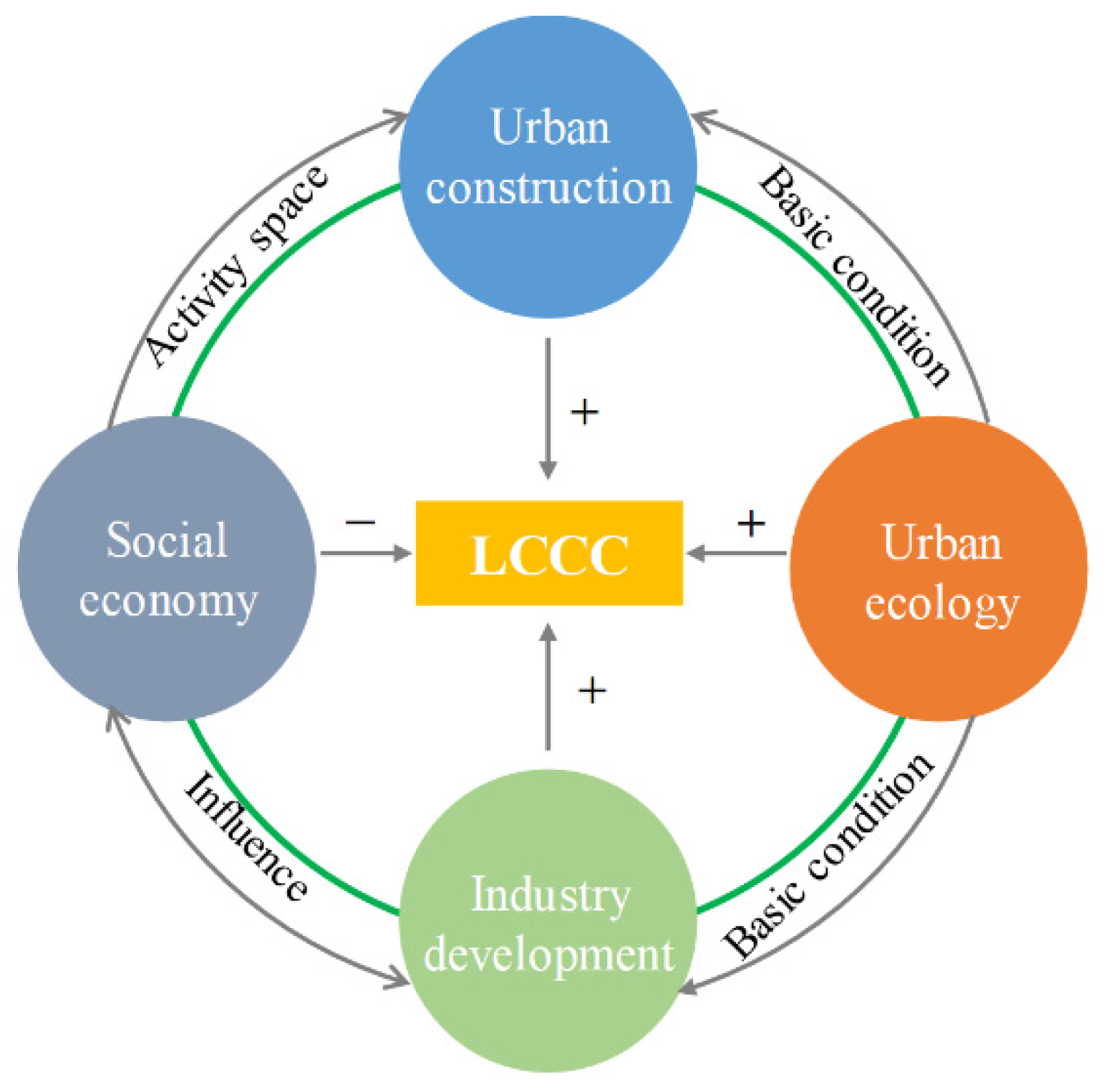
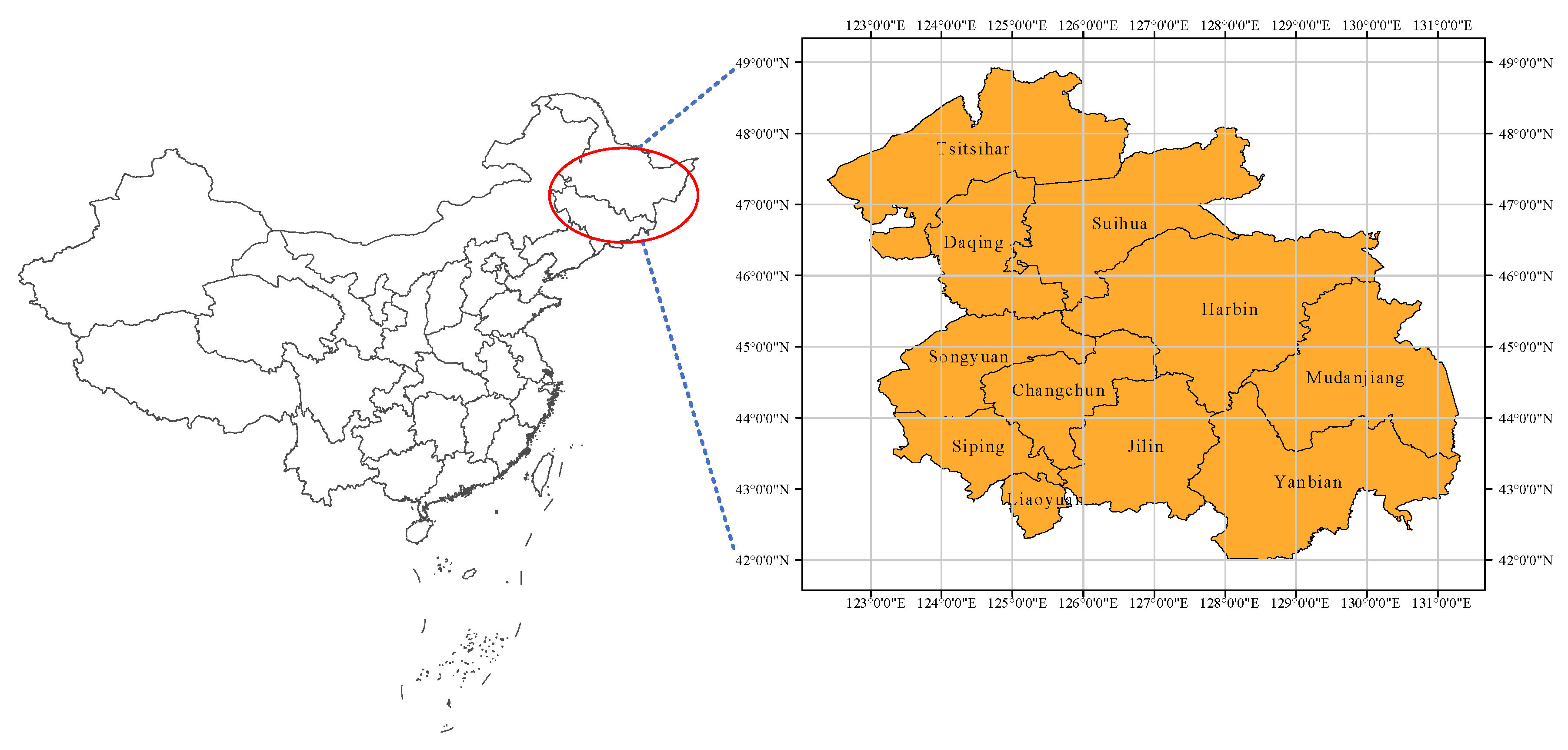
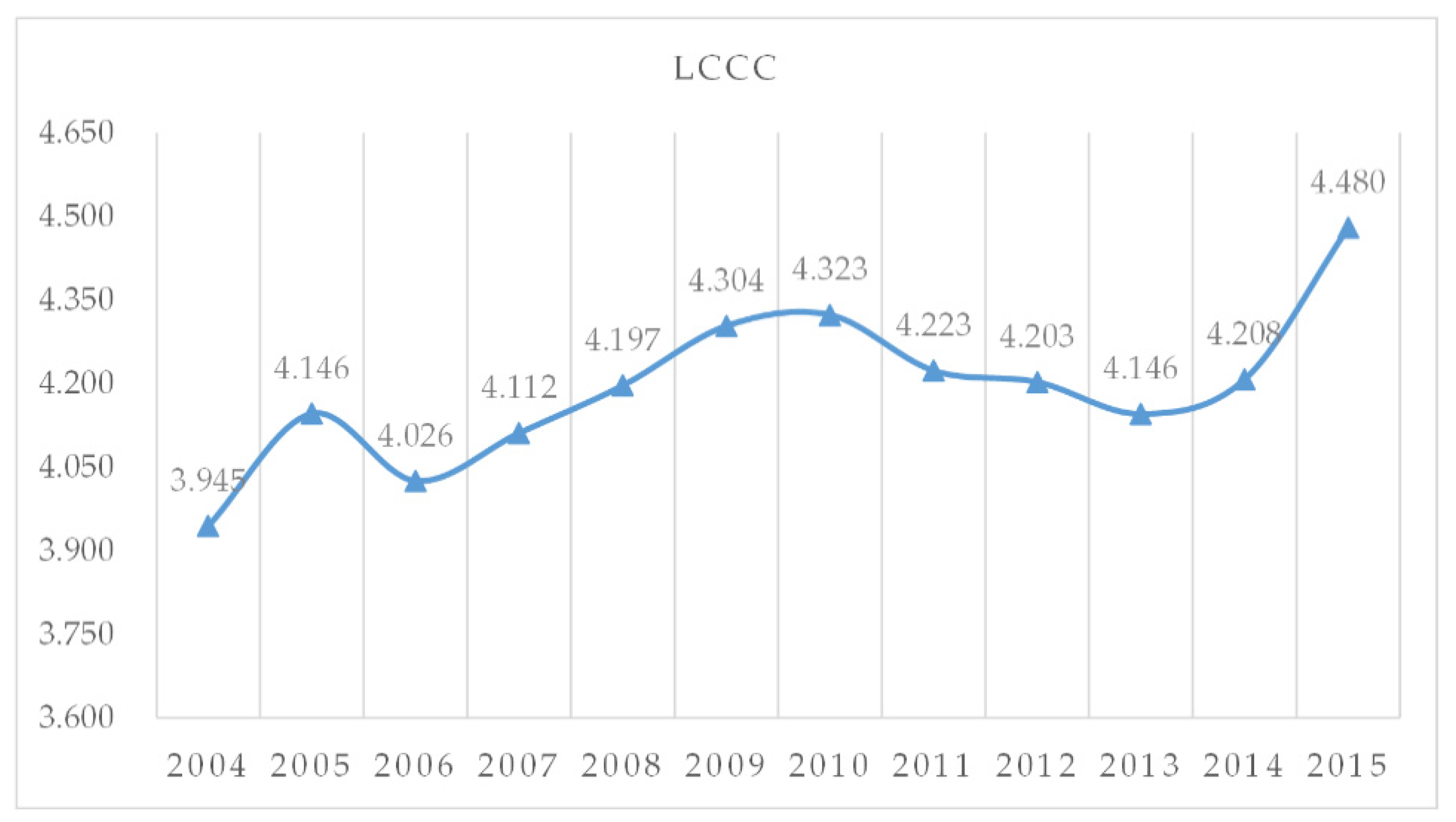

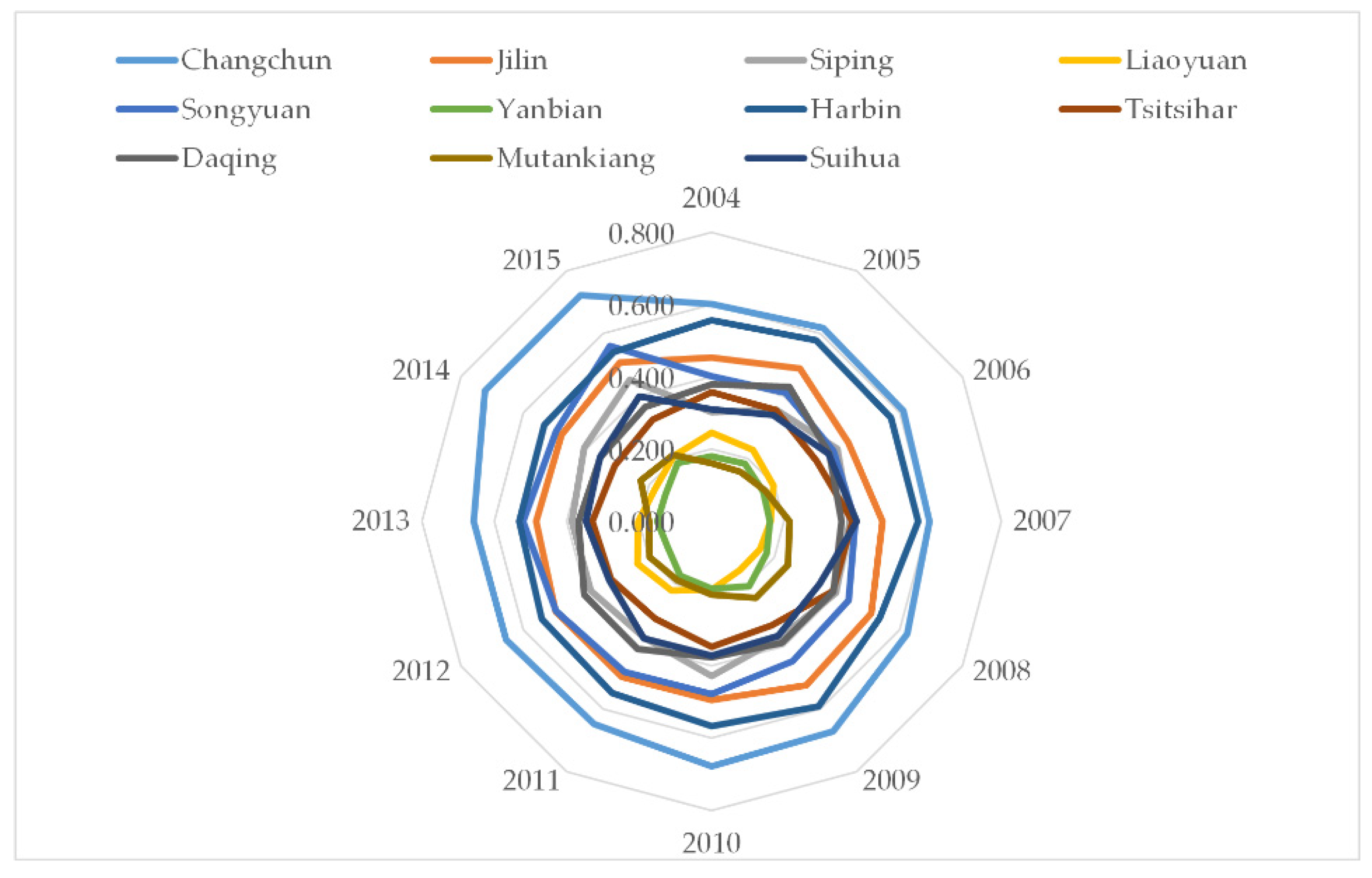
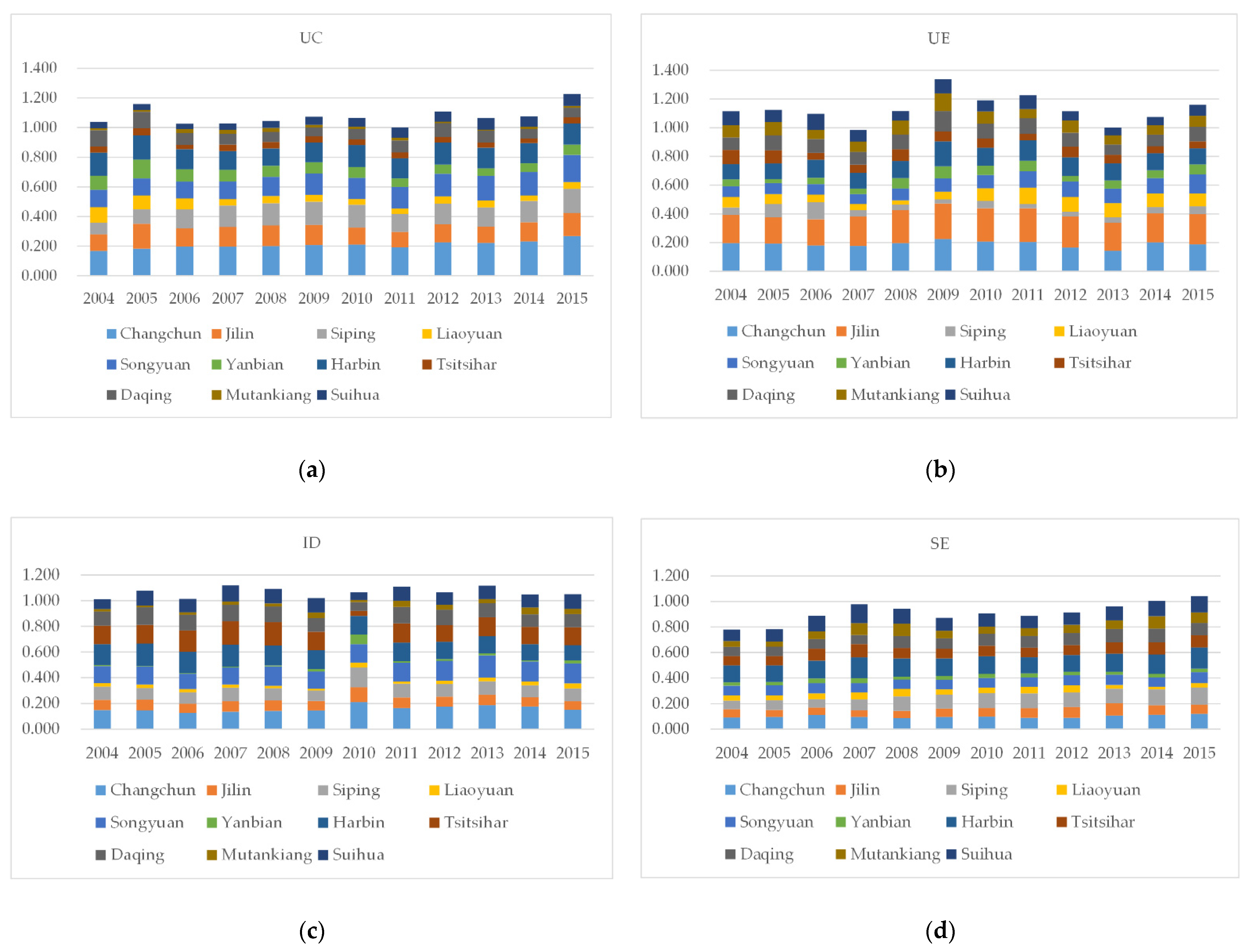
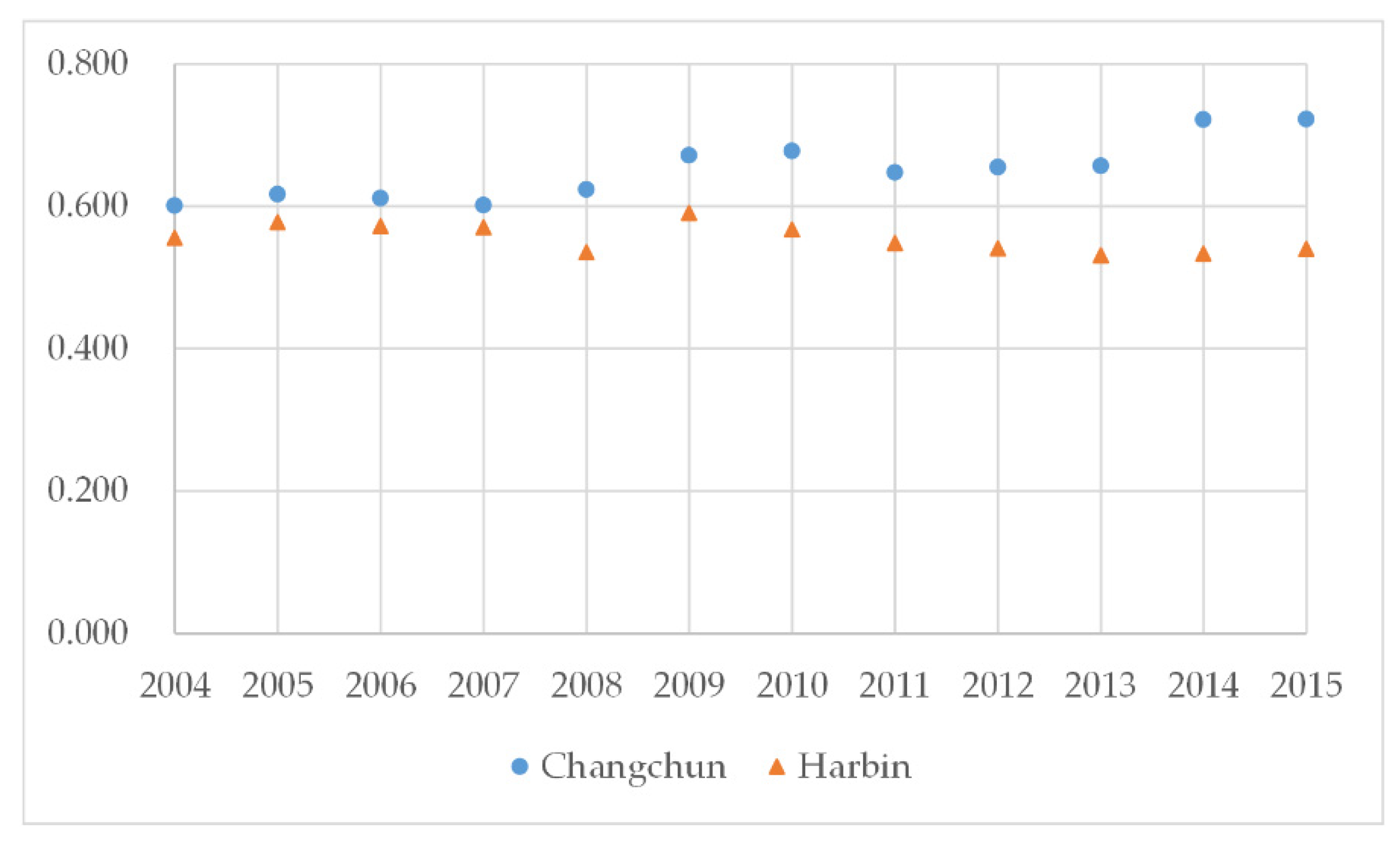

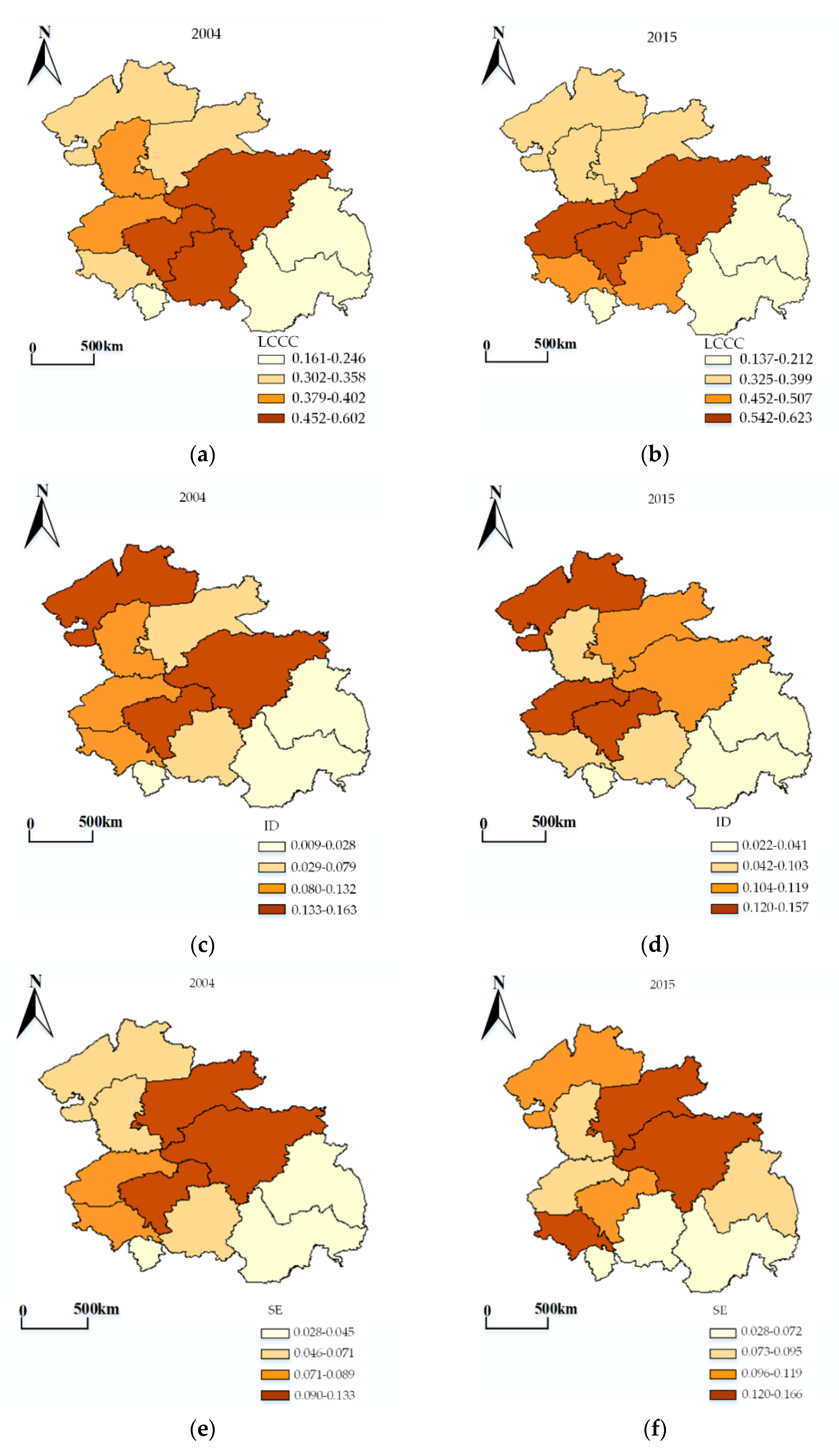

| References | Indicator Dimension |
|---|---|
| [40] | Environment, Resource, Infrastructure, Ecological Civilization, Public Service |
| [41] | Resource supporting capacity, Ecological environment supporting capacity, Economic and technology supporting capacity, Social development supporting capacity |
| [18] | Resource, Eco-environment, Social resources, Economy, and Technology |
| [42] | Land social-developmental, Land ecological-environmental, Land economic-productive |
| [43] | Economic Resources, Environmental, Infrastructural, Transport |
| [44] | Economic, Social, Ecological/environmental/Spatial, Political, Resource |
| Target Layer | Criterion Layer | Index Layer | Units | Description | Weight |
|---|---|---|---|---|---|
| Land comprehensive carrying capacity of the HCUA | Urban construction | Per capita housing area (+) | m2 | Degree of urban land construction and scale of urban living space | 0.121 |
| Road density (+) | km/km2 | Development of construction land | 0.055 | ||
| Per unit area infrastructure investment (+) | 10,000 yuan/km2 | Intensity of land input and output | 0.119 | ||
| Social economy | Economic density (+) | 10,000 yuan/km2 | Output efficiency per unit area of land | 0.092 | |
| Engel’s Coefficient (−) | — | Level of living for residents | 0.068 | ||
| Urbanization rate (−) | % | Scale of population gathering | 0.055 | ||
| Industry development | Per unit area industrial output (+) | 10,000 yuan/km2 | Carrying efficiency and use intensity per unit of land | 0.124 | |
| Per capita grain output (+) | kilogram | Scale of land production | 0.054 | ||
| Per capita farmland area (+) | ha | Support of regional land for industrial development | 0.082 | ||
| Urban ecology | Domestic sewage treatment rate (+) | % | Ecological adaptive capacity of human activities | 0.057 | |
| Per capita public green area (+) | m2 | Quality of the living environment | 0.116 | ||
| Green coverage of urban area (+) | % | Natural condition of land resources | 0.056 |
| Data Types | Data Source |
|---|---|
| Socioeconomic data | Statistical Yearbook of Jilin and Heilongjiang Provinces (2004–2015) |
| Statistical Bulletin of National Economic and Social Development (2004–2015) | |
| Land use data | Resource and Environment Data cloud platform (www.resdc.cn) |
| Resource and environmental data | Environmental Statistics Yearbook (2004–2015) |
| Environmental Status Bulletin (2004–2015) |
| Gradient | Level of LCCC | Cities |
|---|---|---|
| I | Excellent | Changchun |
| II | Good | Harbin, Jilin, Songyuan |
| III | Inferior | Siping, Daqing, Suihua, Tsitsihar |
| IV | Poor | Liaoyuan, Mutankiang, Yanbian |
Publisher’s Note: MDPI stays neutral with regard to jurisdictional claims in published maps and institutional affiliations. |
© 2021 by the authors. Licensee MDPI, Basel, Switzerland. This article is an open access article distributed under the terms and conditions of the Creative Commons Attribution (CC BY) license (http://creativecommons.org/licenses/by/4.0/).
Share and Cite
Tang, Y.; Yuan, Y.; Zhong, Q. Evaluation of Land Comprehensive Carrying Capacity and Spatio-Temporal Analysis of the Harbin-Changchun Urban Agglomeration. Int. J. Environ. Res. Public Health 2021, 18, 521. https://doi.org/10.3390/ijerph18020521
Tang Y, Yuan Y, Zhong Q. Evaluation of Land Comprehensive Carrying Capacity and Spatio-Temporal Analysis of the Harbin-Changchun Urban Agglomeration. International Journal of Environmental Research and Public Health. 2021; 18(2):521. https://doi.org/10.3390/ijerph18020521
Chicago/Turabian StyleTang, Yang, Yongbo Yuan, and Qingyu Zhong. 2021. "Evaluation of Land Comprehensive Carrying Capacity and Spatio-Temporal Analysis of the Harbin-Changchun Urban Agglomeration" International Journal of Environmental Research and Public Health 18, no. 2: 521. https://doi.org/10.3390/ijerph18020521




